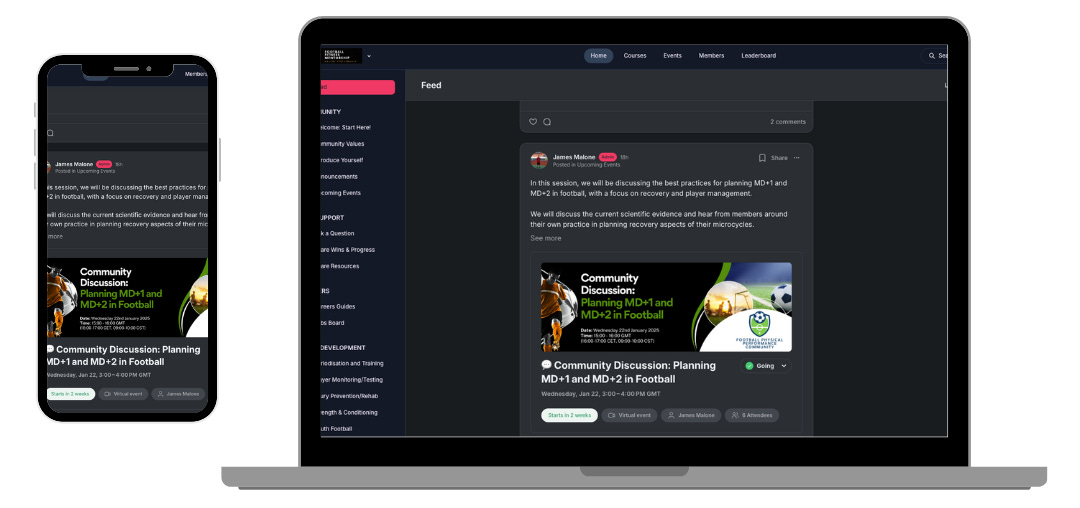The August Balancing Act: Managing Load in the First 4 Games
August is a critical but often neglected phase in the football calendar.
Pre-season is over, competitive fixtures have started and the pressure is back on. But the transition from pre-season to in-season isn’t a flick of a switch - it’s a delicate balancing act.
It’s the period where physical gains can either be consolidated or start to deteriorate. Worse still, poor management here can result in soft tissue injuries, underperformance, or early burnout.
Here’s how physical performance staff can manage this period with purpose.
Taper, Don’t Drop
The final week of pre-season shouldn’t be a last-ditch push. Yet many clubs fall into the trap of “one last big week” to cram in load.
The intention is good - squeeze every drop out of pre-season - but the result is players entering game week one in a fatigued state.
On the flip side, some teams cut volume too aggressively once fixtures begin. But this risks under-loading and rapid detraining.
The answer lies in tapering. According to Bosquet et al. (2007) an effective taper involves reducing volume by 20–60% while maintaining or increasing intensity. This allows fatigue to dissipate while preserving neuromuscular readiness. If done well, tapering can even improve performance by 3–6%.
Therefore, don’t overload or undercook players in the final days before the season starts. Drop volume, not intensity.
Maintain Intensity Midweek
Once competitive fixtures start, matches become the primary load. But match demands don’t always reflect what each player needs to stay robust.
Some players don’t hit sufficient high-speed thresholds or get exposed to enough decelerations and directional changes - especially if they play reduced minutes or in lower-intensity games.
Research by Clemente et al. (2021) highlights that training often underrepresents the high-intensity demands of match play, which means performance staff must design sessions that deliberately include sprinting, high-speed running, and neuromuscular exposure. That’s where a well-structured MD-3 or MD-4 session becomes vital.
This isn’t about flogging players - it’s about maintaining game-relevant intensity so they stay prepared week to week.
Monitor the Trends
Pre-season fitness testing is a great start, but it doesn’t tell you how players are responding in real time. Once the season starts, your feedback loops must get tighter.
Not all players enter August in the same condition. Some have had full pre-seasons, others have missed chunks through injury, illness, or transfer issues. A one-size-fits-all model won’t work here.
That’s where simple, consistent monitoring matters. Wellness questionnaires, RPE feedback, neuromuscular tests (e.g., jump height or peak power), and even player conversations help you spot the early signs of trouble.
As Gabbett (2025) outlined, subjective monitoring combined with load data is one of the best ways to manage injury risk. Don’t wait for red flags - track the trends. The aim is to catch the early warnings before they become time-loss injuries.
Individualise Early
In the first 4–6 match weeks, squad management is just as important as tactical planning.
Players who didn’t complete pre-season, are over 30, or have a history of soft tissue issues shouldn’t be treated like everyone else. They may need reduced match minutes, extra gym work, or careful exposure to deceleration-heavy drills.
This is also the window where strategic rotation makes sense. Use early cup games, five-sub rules, and in-game substitutions to protect high-risk players without compromising performance.
Individualised load management isn’t just for the elite. It’s a scalable principle that applies at every level - especially when data is interpreted through the lens of context, not spreadsheets.
Build While You Compete
Many coaches think the end of pre-season means the end of development. But if players weren’t fully conditioned in July, you can’t afford to stop now.
The key is to keep building physical qualities - especially aerobic fitness, strength, and repeat sprint ability - within the rhythm of the competitive week. This doesn’t mean flogging players on MD+2, but it does mean using smart interventions.
Low-load tempo runs, eccentric strength top-ups, microdosing power work, or even additional individualised ball work can all help close the gap. These sessions should be brief, sharp, and targeted, not layered on top of fatigue.
Remember, physical qualities are perishable. If you don’t keep topping them up, you’ll lose what you gained.
Key Takeaways
Taper volume, not intensity: finish pre-season with freshness and readiness.
Keep intensity midweek: MD-3/4 should feature sharp exposures to preserve speed and power.
Monitor weekly, not monthly: subjective trends often reveal issues before objective data does.
Rotate and individualise: protect high-risk players through smart scheduling and communication.
Keep developing: the first 4 weeks are still a chance to build - not just survive.
Get this phase right, and you’ll buy yourself a more resilient squad come September. Get it wrong, and you might be fighting injury fires for the rest of the year.
That's all for today.
See you next Friday.
James 🫡
P.S. Want to sponsor this newsletter? The Football Scientist reaches 4,000+ high-level practitioners working in elite football every week. Email maloneperform@gmail.com to explore sponsorship opportunities.
🚀 Join The Football Performance Network
Take your career in football to the next level by joining a global community of 60+ physical performance practitioners.
As a member, you'll get:
✅ Direct 1:1 mentorship
✅ Weekly live events with industry-leading experts
✅ Practical, high-quality educational content
✅ A supportive network that understands your journey
Whether you're looking to grow your skills, make better decisions in your role, or build your career in elite football, this is the place to do it.
🔗 Join now and start learning, connecting, and progressing — together.




